The rich timeline that traces Pas Reform’s 100-year history in the hatchery business features many product launches, a steady flow of innovations and continuous expansions through organic growth and acquisitions. But one thing remains the same: Pas Reform’s commitment to deliver the highest number of best-quality chicks!
1900 - 1950 From broody hen to artificial incubation
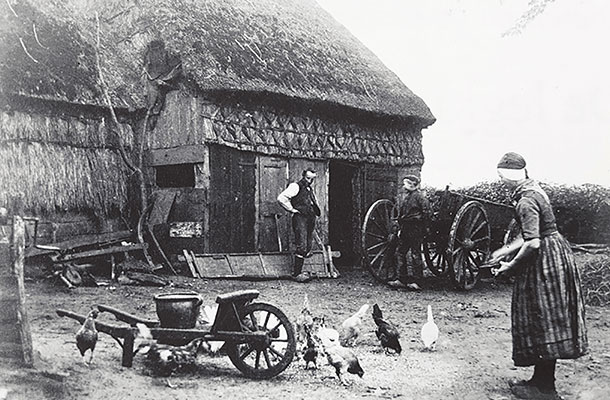
Before 1900 keeping poultry was rarely more than a farmyard staple, to provide meat and eggs for the kitchen table
Until the beginning of the twentieth century the chicken was simply viewed as a farmyard animal and poultry farming was very much a secondary business. The meat was only eaten on very special occasions and eggs that were not for personal use were either exchanged for other necessities, or sold on the local market.
However, the situation changed significantly after 1900. First the availability of cheap imported grain from America and the growing attractiveness of fowls as extra income stimulated the development of commercial poultry farming practices in The Netherlands. This was especially true among the poorer farmers who were making a living on the sandy soils of Gelderland, Brabant and Limburg.
Soon, too, an improved knowledge of genetics, the development of breeding programs and the growing foreign market for egg sales, combined to promote a significant increase in the scale of the sector. The introduction of artificial incubators further facilitated this growth, which in turn opened up the possibilities for specialization.
Another crucial element in the poultry farming industry’s growth in the early 20th Century was the setting up of many local cooperative poultry associations. Through them, local poultry farmers were able to acquire access to the first artificial incubators, which were provided by the associations for joint use by their members.
In those early days the associations had to source the incubators from abroad. This prompted Gerrit Pas – a Zeddam-based farmer by profession, who was also trading agricultural seeds and fertilizers – to import a number of small, 35-egg capacity Glucke-brand incubators from Barmen-Elberfeld (now Wuppertal) in Germany, for resale in The Netherlands.
However, the hatching results with these imports were not to Gerrit’s satisfaction. In 1918, after completing his military service, he decided to develop a new incubator based on his own ideas. With help from his youngest brother, Theo, the Glucke model was hence ‘reformed’ and this gave the company its original name, ‘Reform’.
The development of a new industrial-scale incubator was neither simple nor easy. In order to study the hen’s brooding behaviour, Gerrit positioned a glass plate in an attic floor and placed a brooding hen over it. In this way he was able to study the breeding behaviour of the mother hen and see how often she turned her eggs – learning from nature.
1919
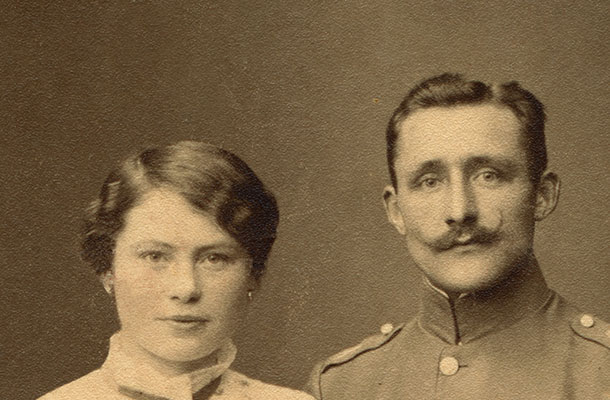
Pas Reform’s story begins in 1919, when Gerrit Pas (1890-1930) turns his skills to developing a new incubation system and establishes the ‘Reform’ incubator factory
In 1919 Gerrit founded the Reform incubator factory in Zeddam. He sold his agricultural lands, converted his farm into incubator production and assembling areas, and turned his skills into developing a new incubation system. Initially, he developed several small incubator models and sold them mainly to small poultry producers in The Netherlands, marketing them as ‘The Gold Standard’ (De Gouden Standaard). His other activities during this time included the manufacture of poultry houses and other related products, such as feeding troughs and brooders.
1920
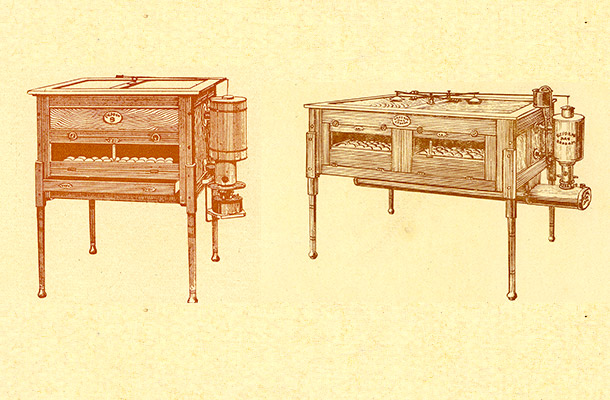
Gerrit develops the Flatbed (Vlakbroeder), Reform’s first branded incubator, with a capacity of 60 hatching eggs and marketed as the ‘Gold Standard’
1921
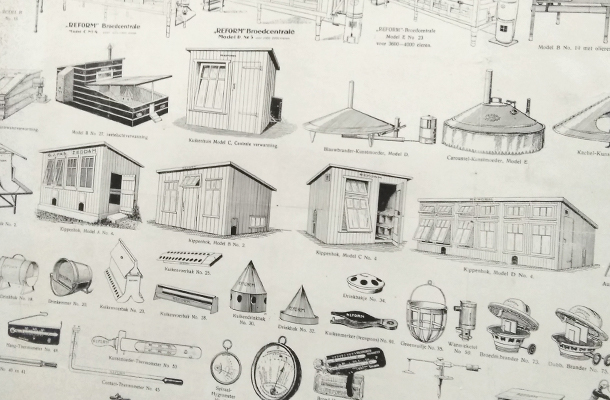
In the 1920s Reform’s activities also include the manufacture of poultry houses and other related products, such as feeding troughs and brooders
Flatbed incubator
Gerrit’s first creation was the so-called ‘flatbed incubator’ (Vlakbroeder). This consisted of a wooden cabinet on four legs, with a horizontally placed tray on which the hatching eggs came to lie. To prevent the embryo from sticking to membranes, the hatching eggs were turned regularly by hand during the incubation process. An oil burner placed outside the cabinet provided the required heat and a water dish attached to this oil burner delivered the required humidity. By adjusting the dish to high or low, the moisture supply in the machine could be regulated as required.
The high demand for day-old chicks that followed the end of the First World War meant that, even using these first flatbed incubators, the industry did not have enough production capacity. As a result, cooperative hatcheries were set up at several locations in central Netherlands, through which the supply of chickens was centralized and scaled up.
These central hatcheries made chicks available to members at cost price, which enabled farmers to restore their poultry stock in a short period of time. By the early 1920s, artificial incubation was taking place on such a large scale that it was labelled as ‘an industry of significance’.
Another important development emerged during the course of the 1920s, when it became increasingly common to keep the hens for only one laying period, instead of two or three. This resulted in the demand for day-old chicks increasing even further.
1925

Reform expands its portfolio by launching the Incubation station (Broedcentrale), with a capacity up to 200 hatching eggs per unit
Incubation station
In order to meet the need for higher capacity incubators, Gerrit moved on to develop the so-called ‘Incubation station’ (Broedcentrale), with a capacity of up to 200 hatching eggs. Launched in 1925, the then revolutionary new system had a compact design and was made up of several small flatbed compartments – each with its own regulator, thermometer and ventilation device. The station was centrally heated with coal-fired warm-water heating, as most farmers did not yet have electricity. The incubation system also featured a semi-automatic turning device, where a flannel-coated slat was moved under the egg tray in the machine with a spindle, so that the incubator no longer had to be opened to turn the hatching eggs.
From the mid-1920s the use of these larger incubators really took off and made a significant contribution to the rapid expansion of the Dutch poultry stock. Over the years, the machines were further developed and became equipped with electric motors and electric heating.
Incubation stations revolutionized the production of day-old chicks – not only in the hatchability, but also in the quality of the chicks. They allowed bulk production with much less labour, resulting in lower production costs. The commercial poultry industry as we know it today was on its way.
By 1925 Pas Reform’s success meant that the original production facilities were becoming too small. However, fate seemed to intervene: there was a large fire, which destroyed much of the Zeddam plant. Following this a new factory hall was built, with a capacity of 250 units per year.
1926
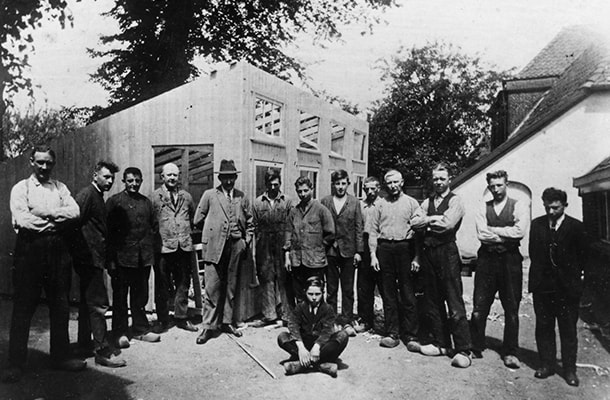
In the mid-1920s Reform expands rapidly and in 1926 a new factory hall is built, with a capacity of 250 incubation stations per year.
Reform factory team in 1926. Gerrit is in the centre, wearing the hat. In that year recruitment of 14 skilled workers help expand Reform’s production capacity
1930
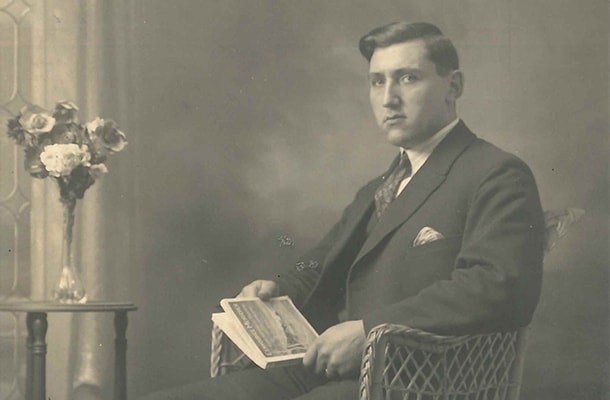
Theo Pas (1901-1986) takes over the business and pulls Reform through the crisis years of the 1930s.
During the late 1920s Gerrit suffered from increasingly poor health and in 1930 he sadly died. At this point his youngest brother Theo, who at that time was in charge of a bodywork factory for buses in Montfoort, joined his sister in law Lena to run the company. He took over all responsibilities in 1931 and had ambitious plans for the future. However, Theo and the company were soon caught up in the crisis years of the 1930s
1931
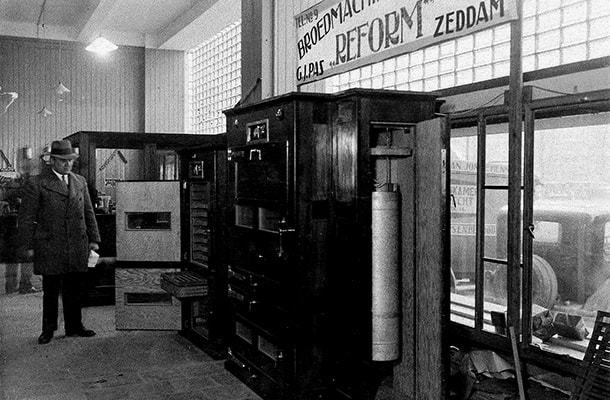
Reform exhibits an Incubation station at the Ornithophilia fair in 1931 in Utrecht, The Netherlands
The strong growth enjoyed in the 1920s was overshadowed by the worldwide economic crisis in the 1930s, which severely set back poultry-sector development. Exports and domestic prices fell sharply. The Dutch government first responded by setting a price guarantee for eggs. Then, in 1933, it introduced the ‘Teeltregeling’, which regulated supply and demand in the sector considerably. To prevent over-production, breeders had to have a license and the breeding season was limited. Farmers could only keep a small number of chickens. This severely reduced the scope for hatchery expansion, and as a result, the sales market for Reform incubators quickly dried up.
This led Theo to focus on the development and manufacture of household electrical items to keep the factory operational – including hotplates, pressure cookers, braziers, lanterns and carbide lamps. In the meantime, however, he worked steadily on the development of a completely new incubation concept, based on his knowledge of electrical engineering and construction techniques.
1932
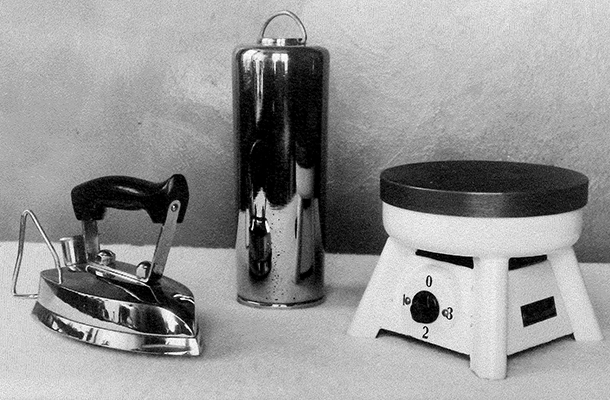
During the crisis years of the 1930s Reform turns to the manufacture of household electrical appliances to keep the factory operational
Optimizing the uniformity of incubation temperature was a vital subject of research in those days. With the incubators available at that time, the constant staring at thermometers and manual adjustment of the settings made incubation a true art.
Theo radically improved this situation with the development of an incubator that incorporated electrical technologies. At the end of the 1930s, as the economic crisis passed, the so-called ‘Drum incubator’ (Trommelbroeder) was put on the market, with capacities of up to 3,500 hatching eggs.
1939
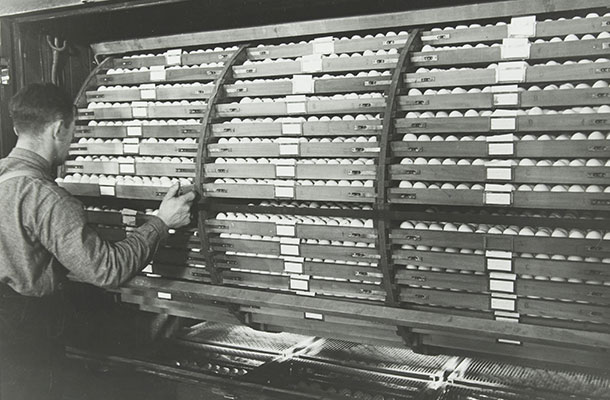
The iconic Drum incubator (Trommelbroeder) makes its debut in 1939, with a capacity of 3,500 hatching eggs
Drum incubator
The ‘Drum’ line of incubators dominates people’s memories of Reform from the late 1930s onwards. This space- and labour-saving concept consisted of a well-insulated, wooden-built cabinet, in which a large open drum was mounted on a horizontal, centrally mounted axis. In that drum, a large number of egg trays could be pushed.
In contrast to its predecessors, the hatching eggs in the drum incubator were incubated in point-down position. This facilitated the turning of all hatching eggs at the same time, by rotating the drum via a simple handle at one end of the central axle.
To ensure that homogeneous incubation temperature and humidity could be maintained throughout the machine, the drum incubator operated according to the forced-air mixing principle. Incoming fresh air was preheated via air ducts in the cabinet deck to avoid cold spots.
The incubator contained four air paddles, which worked like an axial fan. The machine was electrically heated and water-filled baskets provided the right humidity. The ground-breaking innovation of the Drum-type incubators was such that they remained in use until the 1970s.
In these early years, all the key mechanical parts for the incubators were produced in-house. This gave Reform a competitive advantage over other incubator manufacturers, which had mostly originated from the carpentry business or furniture industry and did not therefore have that knowledge themselves.
With the onset of the Second World War at the end of the 1930s, the Dutch government prioritised the use of grain to feed its people, rather than for intensive livestock production. As a result, the country’s poultry population crashed again, which reduced demand for incubators and caused a major crisis for Reform.
To guarantee the company’s survival, the range of electrical appliances was extended further – with irons, electric blankets and hot sand jugs for hospitals, which were made from grenade hulls collected from around Zeddam.
In 1945 Reform’s incubator factory was bombed and the vast majority of stock was lost. However, following Dutch liberation, Theo managed to create temporary production areas and some of the manufacturing activities were outsourced to third parties. As a result, Reform’s incubator production operation was soon open for business again and ready to take advantages of the major opportunities that were to lie ahead.
1950 - 1960 From post-war domestic market recovery to major international expansion
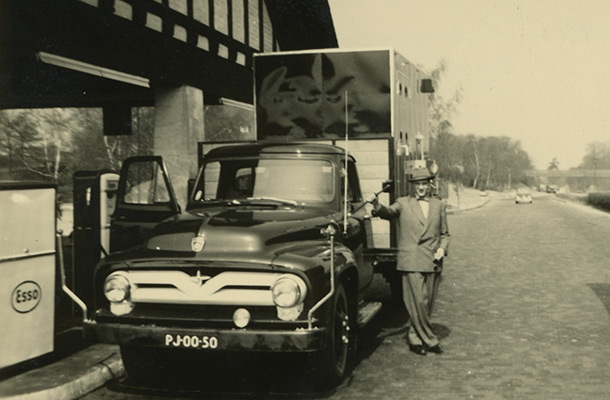
The decade following World War II was a time of strong economic growth. By the beginning of the 1950s, the poultry sector had largely recovered from the most direct consequences of the war. Production of poultry meat and eggs was gradually industrialized again to pre-war levels, accompanied by economies of scale in production. The need for large incubators grew considerably and this led to Reform’s strategic return to its core activity.
The first major post-war factory expansion was completed in the spring of 1949 and a second large expansion was completed five years later.
1950
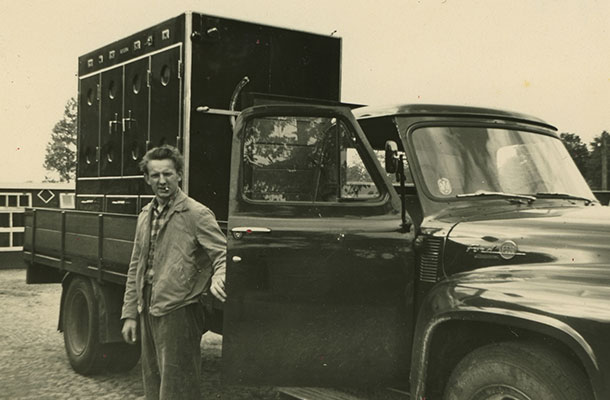
In the early 1950s the drum-type incubator finds a ready market in The Netherlands, and is also welcomed by hungry foreign markets
The Drum-type incubator had found a ready market in The Netherlands, but large incubators were also welcomed by hungry foreign markets. Thanks to the creation of the European Economic Community and its agriculture policies, the 1950s saw Reform take its first steps to internationalize – in search of new markets and business opportunities, first in Europe and then overseas.
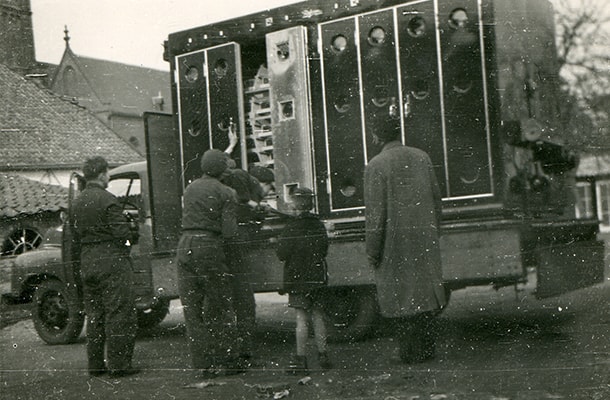
Reform internationalizes in search of new markets and business opportunities. The company starts to establish a sales network, first across Europe and then beyond
In 1950, to drive export sales, an agreement was concluded with Valynco in Bussum for the export of incubators. Sales subsidiaries were established in Germany (Reform Verkauf GmbH in Oldenburg) and Italy (Eugenio Fontana Impianti in Milan), which delivered strong growth in these countries. During the early 1950s, export markets were also developed in France and Switzerland. At this time, incubators were loaded onto trucks or railway wagons in Venlo and arrived fully assembled at their final destination.
1951
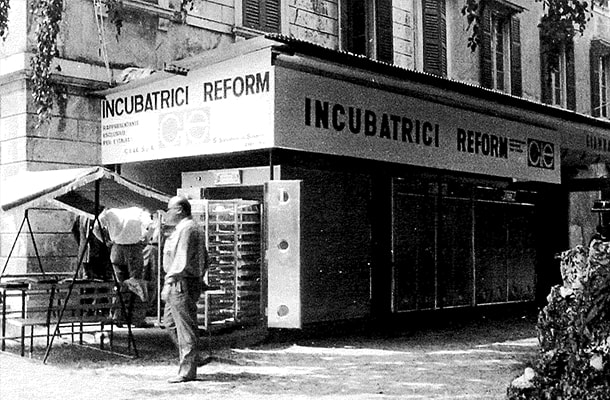
In the early 1950s sales subsidiaries are established in Germany and Italy, which deliver strong growth in these countries
1956
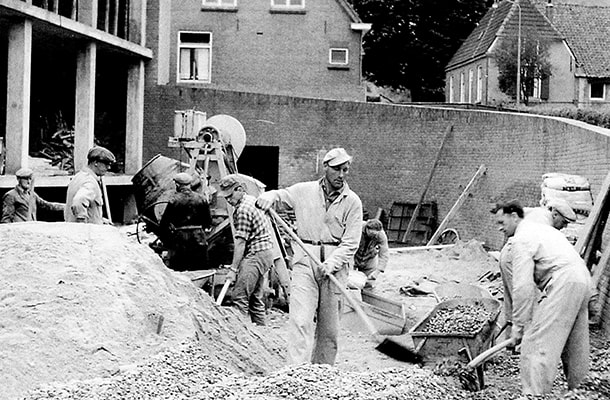
Building blocks of the future: post-war factory expansions in the mid-1950s, to keep pace with the company’s international expansion
Meanwhile, expansion of Reform’s operations also continued at its headquarters in Zeddam. An adjoining plot of land was purchased for a new extension, which included a modern new office building.
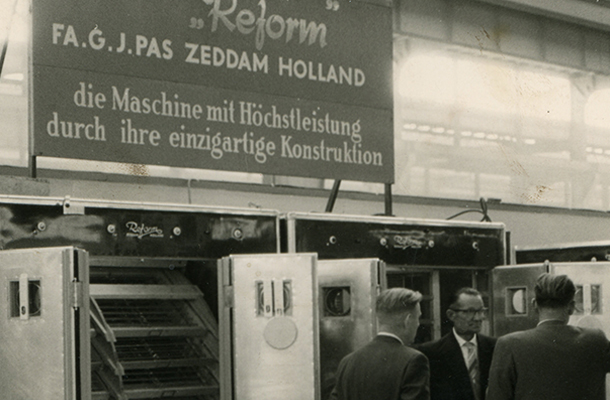
In the mid-1950s Reform introduces major developments in the construction of the drum incubator
During this time, Theo introduced major developments in the construction of his drum incubator. For example, egg turning became fully automated. It was also becoming increasingly commonplace to replace the wooden cabinet with aluminium – for more effective thermal insulation. This, combined with pre-heating and low Wattage heating devices, made it possible to run the incubation process with low-speed air circulation –and resulted in the lowest energy consumption per egg place in the market.
In the years that followed, Theo also redesigned the Drum machine with essential ergonomics in mind. By locating the hatcher section of the machine behind the setter section, instead of beneath, it was possible to load and unload the hatching section from a standing position.
Another major advantage of separate setting and hatching sections was the fact that the hatching section could be thoroughly cleaned and disinfected after a hatch without adversely affecting the incubation process in the setting unit. In addition, the incubator was considerably lowered in height, which made installation in hatcheries with a rather low ceiling much easier. Importantly, too, the new incubator layout led to substantial energy savings, because the hatching unit no longer had to be heated in between two hatches.
1960 - 2000 From multi-stage incubation to automated single-stage incubation
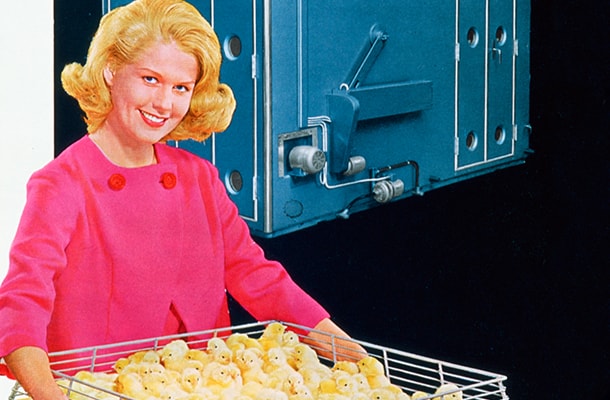
1958
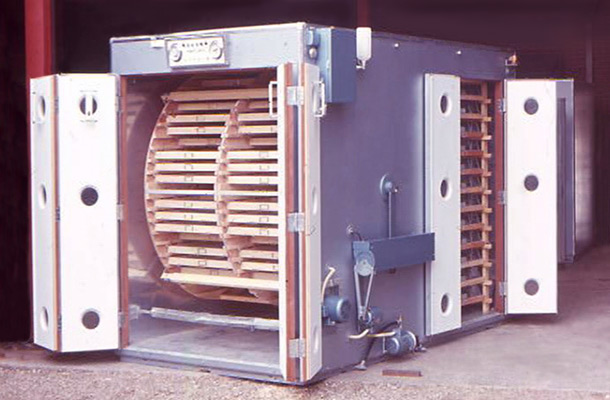
By the end of the 1950s the drum incubator is further developed - by locating the hatcher section behind the setter section of the drum incubator
During this period of international expansion Theo’s oldest sons – Gerhard and Henk – joined the family business and professionalised the company’s management approach. The brothers had practically grown up with Reform and they were involved in the business naturally from an early age. Gerhard first started in sales and Henk became involved in R&D.
The company’s new organizational structure was timely as, from 1960 onwards, the international hatchery industry developed rapidly. This was the catalyst to drive important technological changes and for Reform to continue to scale up its operations.
With the ever-increasing size of hatcheries, both the capacity of incubators and labour efficiency had to be increased. It was for these reasons that a newly developed, fully automated, high capacity, single-stage incubation system – consisting of separate setters and hatchers – gradually replaced the drum incubator. The Pas brothers played a crucial role in this innovation, which drove the company towards further growth and expansion.
1966
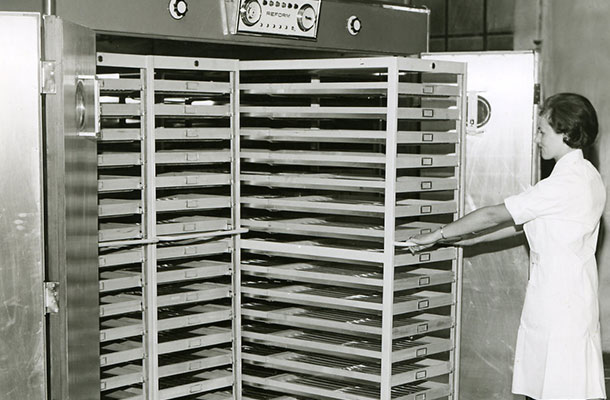
Reform introduces the ‘Single-Stage’ incubator, with a capacity of 100,800 hatching eggs. Named the Drive-In, it completely changes the hatchery business
Single-stage incubator
Reform’s track record for innovation continued throughout the 1960s with the introduction of the single-stage incubator. Until that time, the incubation industry was based entirely on the multi-stage incubation methodology – where eggs are typically placed into incubators at three-day intervals, resulting in incubation of multi-age embryos. The main difference from those existing incubators was that the single-stage incubation system consisted of separate setting and hatching units, in which eggs of a single age could be incubated on trays on mobile trollies.
In addition, this new type of incubator incorporated a whole range of other process and technological advantages. These included automatic control of heating, cooling and humidification, and an electronic temperature-control alarm. Its smaller footprint and the trolley based movement of trays provided simplified, labour-saving working conditions and also made for easier cleaning and maintenance.
So, while the world’s hatchery sector has seen a massive shift to single-stage incubation in the 21st century, Pas Reform has, in fact, been leading in this area since the 1960s!
1968
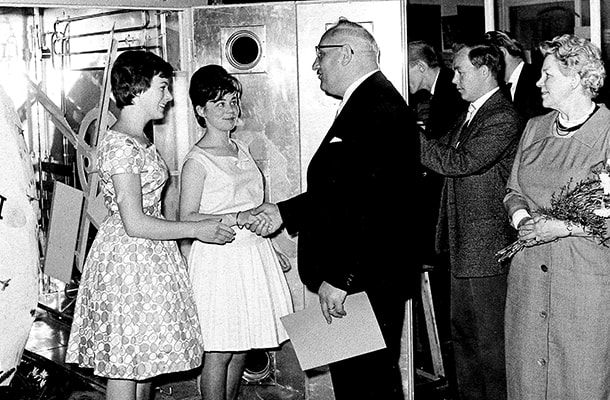
Success to be celebrated: Reform delivers its 1000th single-stage incubator
Market demand for Reform’s single-stage incubators grew substantially, as the poultry industry started to recognize that a short hatch window and uniform, robust chicks are critical to obtaining the best performance. The impact of effective single-stage incubation strategies – expressed in terms of improved hatchability, growth rate and feed conversion ratios – was felt throughout the entire poultry value chain.
Incubators of this type are used up to the present day. Their performance has continued to improve over time, thanks to ongoing design improvements. Before the end of the twentieth century, Reform had successfully launched a series of successor models, including Drive-In, Atlas and Corridor.
1969
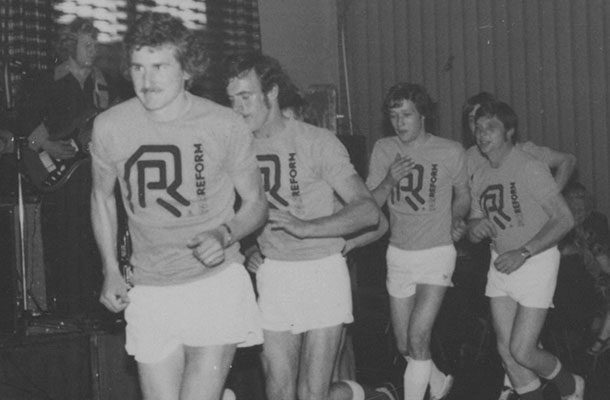
Reform is renamed ‘Pas Reform’ and reveals a new, modernized brand design
At the end of the 1960s ‘Reform’ changed its name to ‘Pas Reform’. At this time the company also revealed a new brand design, which introduced the ‘PR’ logo and red became the leading brand colour.
In 1974 Theo’s youngest son, René, finished his University studies and he assumed responsibility for production. At the same time Theo – who had played a pivotal role in making Reform the company it is today – stepped down as CEO, while continuing as Chairman of the Shareholders Board.
During the years that followed there were many other major changes in Pas Reform’s manufacturing processes and product development, which combined to revolutionize construction completely.
Cabinet production was transferred to a new location and work began on manufacturing PU-foam sandwich panels. Setter trays, hatcher baskets and many other incubator parts were redesigned into injection-moulded products. Patented pulsators were introduced for optimum temperature homogeneity in the incubator.
To reduce shipment volume, incubators were no longer shipped completely assembled, but delivered as kits that were erected at the customer’s hatchery site. Pas Reform also began selling hatchery automation and climate control systems. A multi-fiber optic system for in-line candling was introduced in 1976, and the first semi-automatic transfer system for eggs from setter trays into hatcher baskets was introduced in 1977.
1978

Pas Reform becomes The Netherland’s first industrial equipment manufacturer to introduce microprocessors for its process control and alarm functions
A year later, Pas Reform became The Netherland’s first industrial equipment manufacturer to introduce microprocessors for its process control and alarm functions.
Throughout the 1970s, Reform went on to win overseas markets for its single-stage incubation technologies, and a significant new phase of business internationalization began. By this time, the company’s export activities extended to other European countries and also far beyond.
1981
In 1981, Nijkerk-based incubator company Econoom was acquired. The brand was withdrawn from the market, but as a result of the take-over Pas Reform’s service base was substantially increased – both in The Netherlands and abroad.
1982

Before the end of the twentieth century, Pas Reform successfully launches a series of single-stage models, including Drive-In, Atlas and Corridor
1984

The Ten Cate family takes over the Pas Reform family business, providing new opportunities for business expansion
In the early 1980s, despite the success of the single-stage incubator, Pas Reform experienced difficult times – because of stagnant sales to the Middle East and the eastern bloc countries. In 1984 the Ten Cate family took over the Pas Reform family business, which provided the company with new opportunities for business expansion. The company was later transferred to Hydratec Industries NV, of which the Ten Cate family is still the major shareholder. Hydratec is a globally operating, stock-listed technology group, with specialism in the Agri & Food, Health Tech and Automotive markets.
By the end of the 20th century Pas Reform had established its self as a major player in the global poultry industry, with customers in more than 80 countries. It was perfectly placed to take advantage of the next technological revolution, which was to be based on hatchery process integration, advanced computer control, sustainability and digital connectivity.
2000-2019: From incubator manufacturer to supplier of integrated hatchery solutions
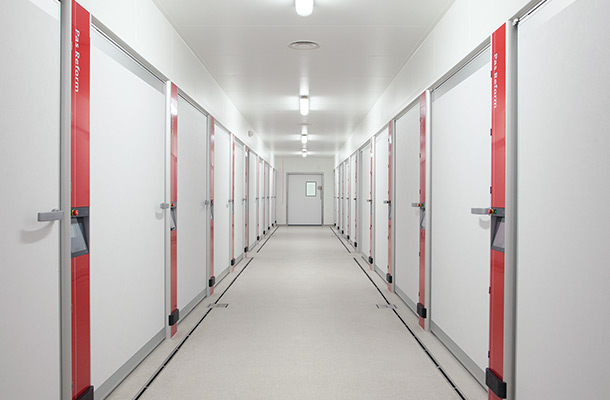
Today Pas Reform’s head office is almost exactly where our company founder Gerrit Pas first created his new incubator in 1919. Throughout its many expansions, the company has never left its birth place.
In this century, global demand for poultry and eggs continues to rise – both due to the growth of the world’s population (projected to reach 9.8 billion in 2050) and the rising prosperity among developing economies. These market developments have resulted in sector growth and dramatic increases in the size of commercial hatcheries.
To maintain the high levels of process management being demanded of them, these large-scale facilities require fully integrated and connected process control. Pas Reform has seized this growth opportunity with both hands – by investing in its transition from an incubator manufacturer to supplier of integrated hatchery solutions. With a focus on our customers’ future, incubation is now combined with advanced climate control and a complete range of hatchery automation systems.
However, Pas Reform’s job is to both supply fully integrated hatchery solutions and ensure that this equipment continuously delivers the highest numbers of best-quality chicks for our customers. To achieve this, the company has also introduced a comprehensive package of services – from which customers can tailor exactly the support they need to maintain optimized hatchery performance.
By super-connecting incubation, automation, climate control and service, Pas Reform has created a strong platform for growth. The company has also been able to significantly enhance its customer service and support levels – thanks to ever-greater insight into, and control of, the whole incubation process.
To manage this growth in a responsible way, Pas Reform is continuously searching for more sustainable, intelligent and innovative ways to handle valuable day-old chicks with minimum impact on their health and well-being.
2001
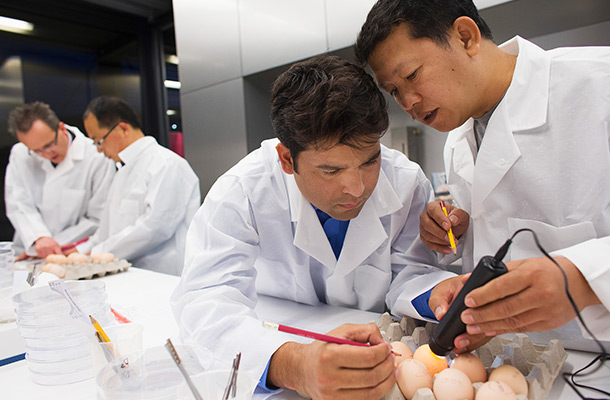
Pas Reform Academy is established, driving new product development and hatchery management training
Since 2001 Pas Reform Academy has been at the heart of our business. In close co-operation with customers and universities, our specialist team carries out research into the influence of the incubation process on chick embryo development. This expertise is used to develop innovative new products and services for the hatchery industry and to train and coach hatchery managers.
2004
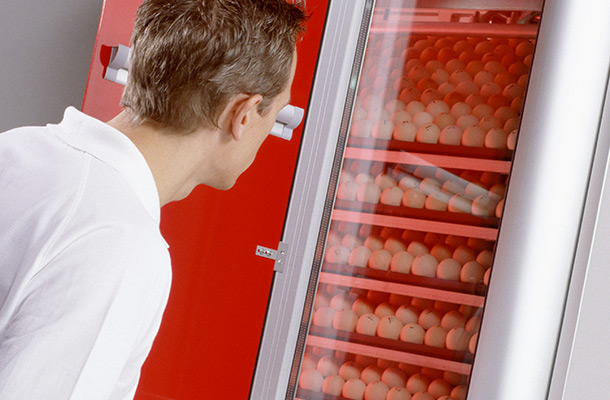
Pas Reform launches Smart™ single-stage incubation technologies
In 2004 Pas Reform launched its first generation Smart™ incubation technologies. Smart™ meets the key challenges of genetic advancement and uniformity. Modular, single-stage incubation delivers precise, homogeneous, temperature control throughout the incubation cycle. SmartCenter™ captures every minute piece of information from the entire hatchery – from incubation cycles, to the movement of eggs and the management of stock. This detailed information means the hatchery can be better managed – resulting in a shorter hatch window and greater numbers of healthy, uniform and robust day-old chicks.
2005
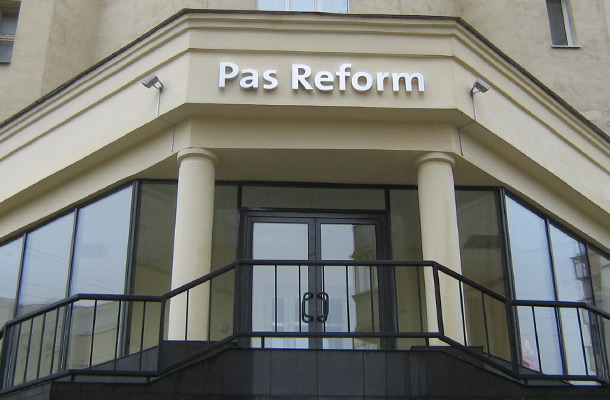
Pas Reform Russia opens in Belgorod, Russia
2008
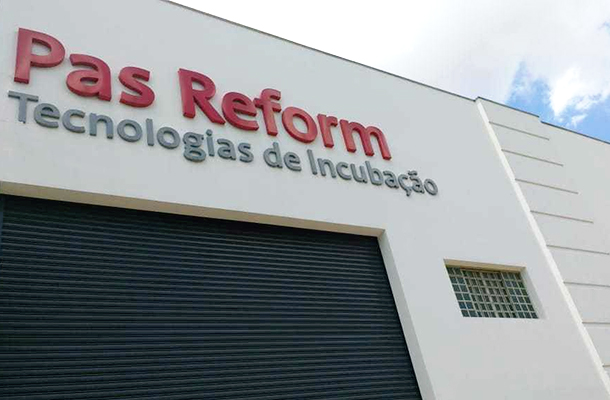
Pas Reform do Brasil is formed
Global expansion in the early 2000s brought about new and developing markets. Pas Reform opened for business in Russia in 2005, followed by Pas Reform do Brasil in 2008.
2010
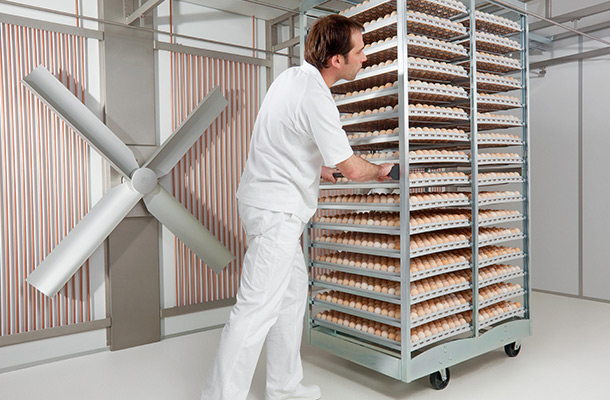
Pas Reform launches SmartPro™ single-stage incubation technologies
In 2010 second-generation SmartPro™ single-stage incubation technologies were being launched worldwide.
2011
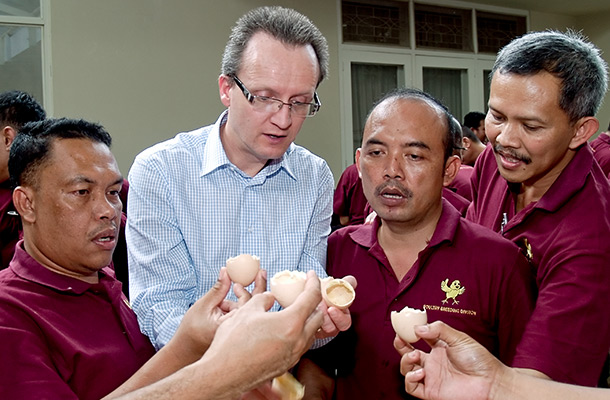
Pas Reform opens new offices in India, Indonesia and Malaysia
2011 was another year of significant expansion for Pas Reform. New offices were opened in India, Indonesia and Malaysia.
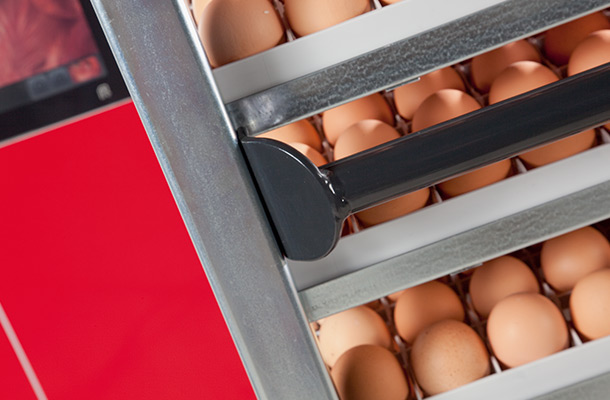
Pas Reform’s incubation system receives a GIO Award for good industrial design
In 2011 Pas Reform qualified for a GIO (Good Industrial Design) Award for its SmartPro™ incubation system – a testament to the knowledge, dedication and passion of Pas Reform’s R&D, product development and engineering teams.
2012
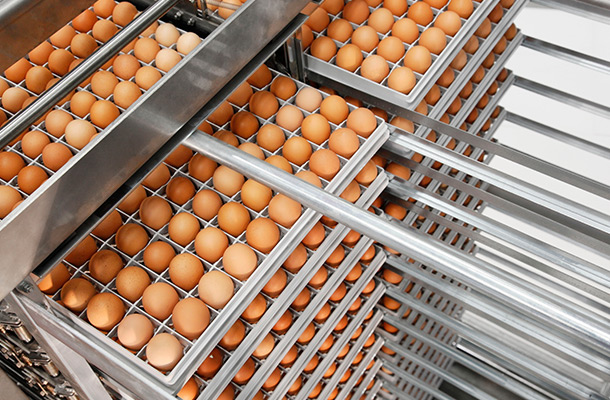
Pas Reform acquires Lan Handling Technologies
In 2012 Pas Reform consolidated its hatchery automation division with the acquisition of Lan Handling Technologies, a specialist in custom-made handling solutions.
2013
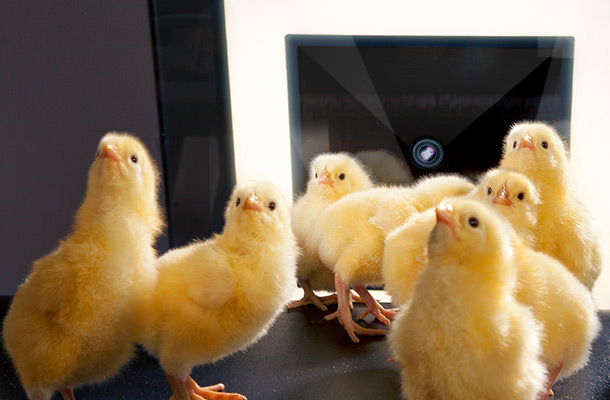
Pas Reform introduces the animal friendly SmartCount™ counting and dosing system
In 2013 Pas Reform introduced SmartCount™ – a new, animal-friendly system for chick counting and quality analysis, which combines high capacity with gentle handling of day-old chicks and improved traceability.
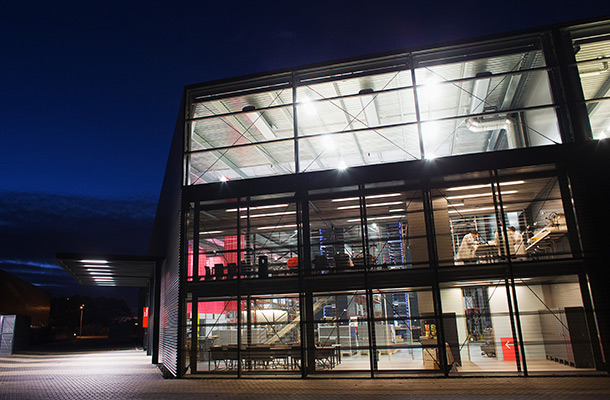
Pas Reform opens a new Global Distribution and Training Center in Doetinchem, The Netherlands, and wins the national Building of the Year Award
Since 2013 Pas Reform products have been shipped to customers from our state-of-the-art distribution and logistics centre at Doetinchem in the east of The Netherlands, which is less than eight kilometres from our Zeddam HQ. The 4,500 m2 distribution centre supports a global ordering and service system.
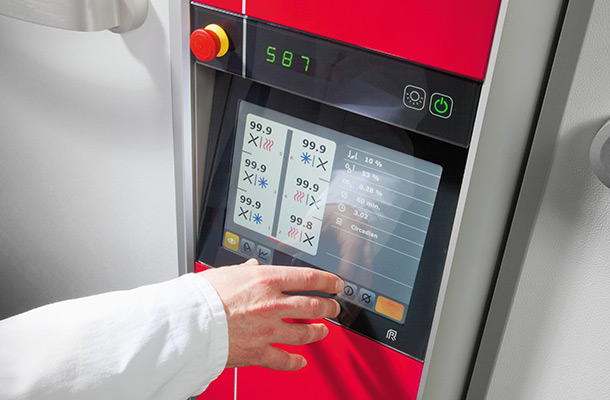
Pas Reform’s SmartPro™ incubation system receives a prestigious international ‘Red Dot’ award for high design quality
In 2013 Pas Reform’s SmartPro™ incubation system was awarded a prestigious international ‘Red Dot’ award for high-quality design. In a statement from the awarding Jury, Pas Reform’s latest development in single-stage incubation was highly praised: ‘The SmartPro™ incubator manifests a clear, comprehensible design and fulfils the highest demands expected of technologies for incubation in terms of reliability and user-friendliness.’
2014
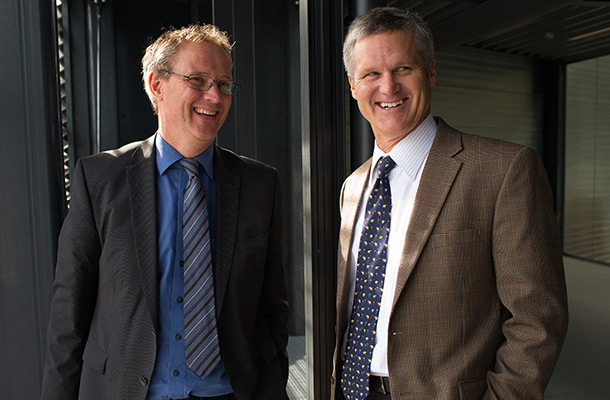
Pas Reform expands into the US, with the integration of NatureForm Hatchery Technologies
In 2014 Pas Reform expanded into the US, with the integration of US company NatureForm Hatchery Technologies. This was a landmark moment in Pas Reform’s international expansion, delivering expansion of our product range and improved service and support to our North American customer base.
2015
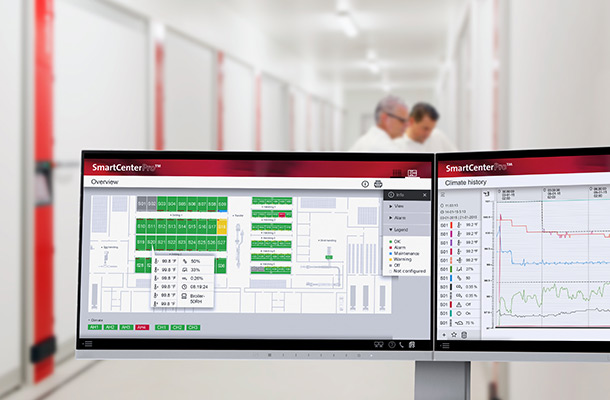
Pas Reform launches the SmartCenterPro™ hatchery management system
By 2015 increasing numbers of Pas Reform’s incubation, climate control and automation systems were being linked using the SmartCenterPro™ hatchery management system. SmartCenterPro™ is a hatchery information system created to deliver precise, consistent process control, analysis and reporting for every level of hatchery operations. Incubation, climate control and hatchery automation systems can all be fully optimized, seamlessly connected and data enabled – from the receipt of hatching eggs, to sending the day-old chicks to the farm. The output is a unique cycle report, which contains batch-specific information on traceability, chick uniformity, hatcher climate, hatchery climate and alarms.

In 2015 Harm Langen is named as the new CEO of Pas Reform, succeeding Bart Aangenendt, who takes over as CEO of Holding Company Hydratec Industries NV
In 2015 Harm Langen was named as the new CEO of Pas Reform. He succeeded Bart Aangenendt, who took over as CEO of Pas Reform’s Holding Company, Hydratec Industries NV.
2016

Pas Reform launches SmartPro™ NF, to accommodate a wide variety of tray types
Pas Reform’s SmartPro™ product range expanded in 2016 with the NF Series, to accommodate a wide variety of tray types, including both US and European sizes.
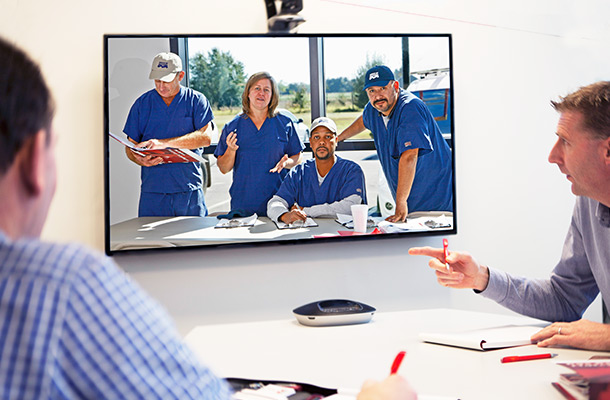
Pas Reform introduces the SmartCare™ service and support programme
In 2016 Pas Reform introduced the SmartCare™ programme – to provide a best-in-class service for our customers and ensure that our hatchery solutions consistently deliver the highest number of best-quality chicks. This features 21 services, from which our customers can select exactly the support they need to optimize their incubation process. The services extend to maintenance advice, training programmes for users, remote monitoring, frequent check-ups and optimizing operational processes. Today our business solutions are no longer built around the average Pas Reform customer, they are designed to meet the specific needs of each one individually.
2018
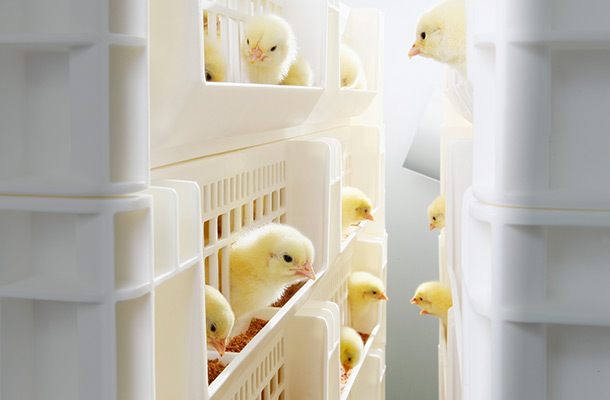
Pas Reform launches the SmartStart™ post-hatch feeding solution
In 2018 Pas Reform launched SmartStart™, which uses natural, deep-eutectic solvents (NADES) to retain water inside a semi-moist feed for a practical, simple, post-hatch feeding solution. SmartStart™ comprises two key elements – precision feeding and intelligent lighting – which can be applied individually or together. The system performs well in the warm conditions of the hatcher and enables chicks to eat from the moment of hatching. This promotes the development of robust day-old chicks and reduces the need for antibiotics.
2019
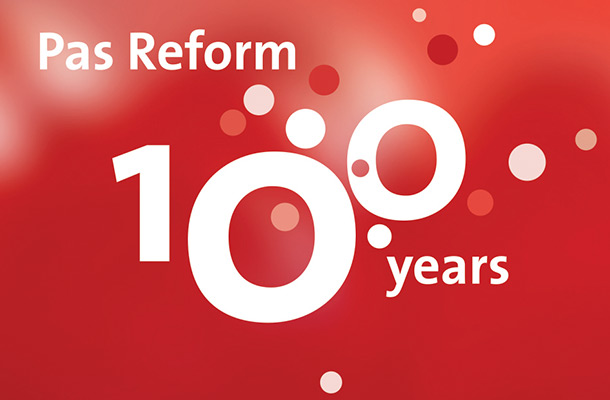
Pas Reform celebrates 100 years as a company
In 2019 Pas Reform is the world’s only single-source provider of integrated hatchery solutions. It is the result of 100 years’ experience in the poultry business, with more than 50 years of expertise in single-stage incubation technologies.
In addition to its operations in The Netherlands, Pas Reform today has a global network of 11 sales and service centres and a team of more than 150 staff – located in Brazil, China, India, Indonesia, Malaysia, Mexico, Russia, Saudi Arabia, South Africa, Thailand and USA. Combined with a large network of 46 experienced sales representatives, we can meet the needs of customers across the world.